You might think designing a storage room is as simple as throwing up some shelves and calling it a day, but there’s actually a science to creating the perfect organized space. I’ve helped dozens of homeowners transform their chaotic closets and cluttered corners into efficient storage solutions that make finding items a breeze. Whether you’re working with a tiny closet or a spacious basement, I’ll show you how to maximize every square inch and create a system that’ll actually stick.

Assess Your Space and Storage Needs
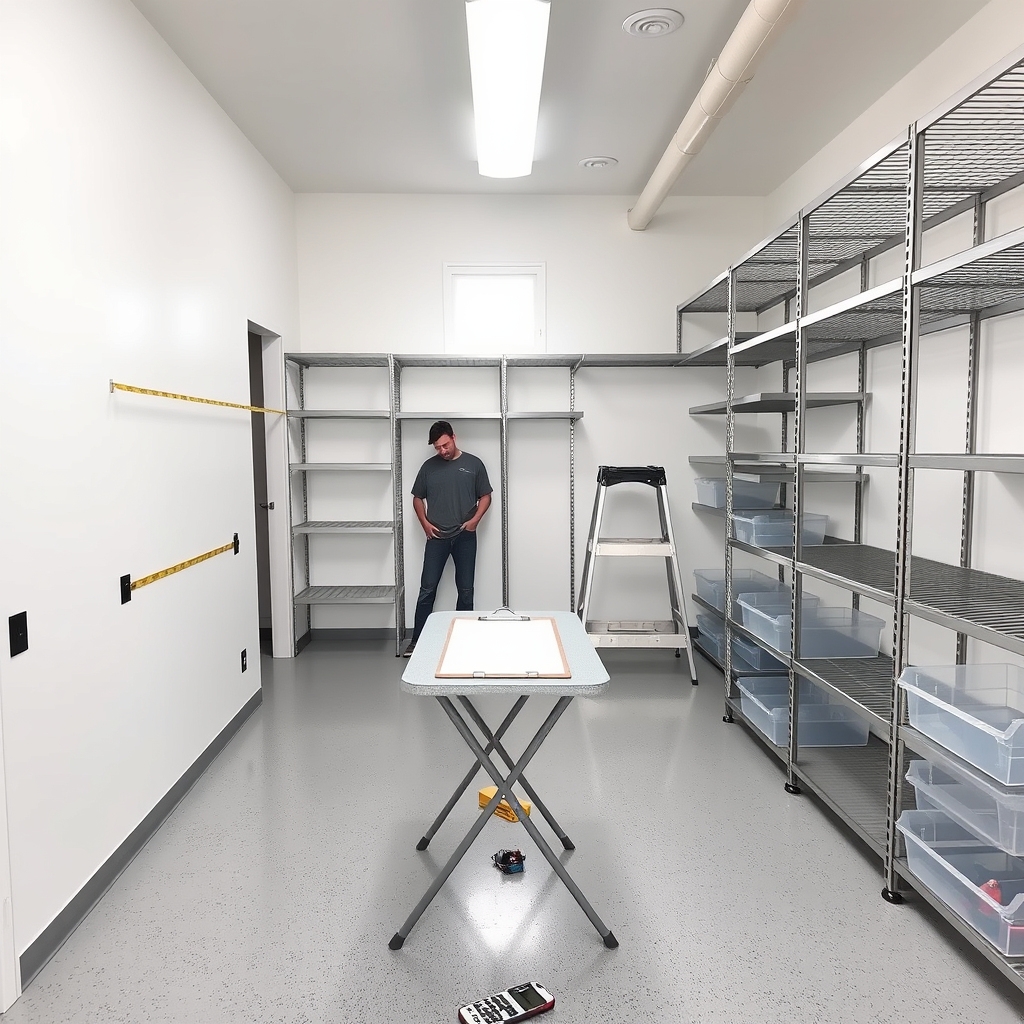
A well-planned storage room starts with a thorough assessment of both available space and storage requirements. This critical first step prevents common pitfalls like overcrowding, inefficient use of space, or creating a system that doesn’t match your actual needs. Taking time to evaluate your space and storage needs helps create a functional, organized solution that will serve you long-term.
Understanding your specific storage requirements involves examining not just what you currently own, but also considering seasonal items, future needs, and how frequently you’ll need to access different categories of items. This evaluation process forms the foundation for all subsequent organizing decisions, from choosing storage systems to determining layout and accessibility requirements.
Required Items:
- Measuring tape
- Note pad and pen
- Calculator
- Camera or smartphone
- Graph paper
- Empty boxes for sorting
- Labels
- Inventory sheets
- Floor plan template
- Level
Start by measuring your storage room’s exact dimensions, including ceiling height, door width, and any architectural features like windows, outlets, or built-in elements. Create a detailed floor plan, noting potential obstacles or limitations.
Next, conduct a comprehensive inventory of items requiring storage, categorizing them by size, frequency of use, and seasonal relevance. Calculate the cubic footage needed for each category while considering appropriate storage solutions like shelving, bins, or hanging systems.
Analyze traffic patterns and accessibility needs, determining which items require quick access and which can be stored in less accessible areas. Consider vertical space utilization, including ceiling-mounted storage options and wall-mounted systems. Document specific storage requirements for special items like holiday decorations, sporting equipment, or valuable collections that may need climate control or extra protection.
For optimal results, incorporate a 15-20% space buffer in your planning to accommodate future storage needs. Consider implementing a zone system, designating specific areas for different categories of items based on use frequency and size.
Regular reassessment of storage needs and space utilization helps maintain an efficient and adaptable storage system that grows with your changing requirements.
Clear Out and Categorize Your Items
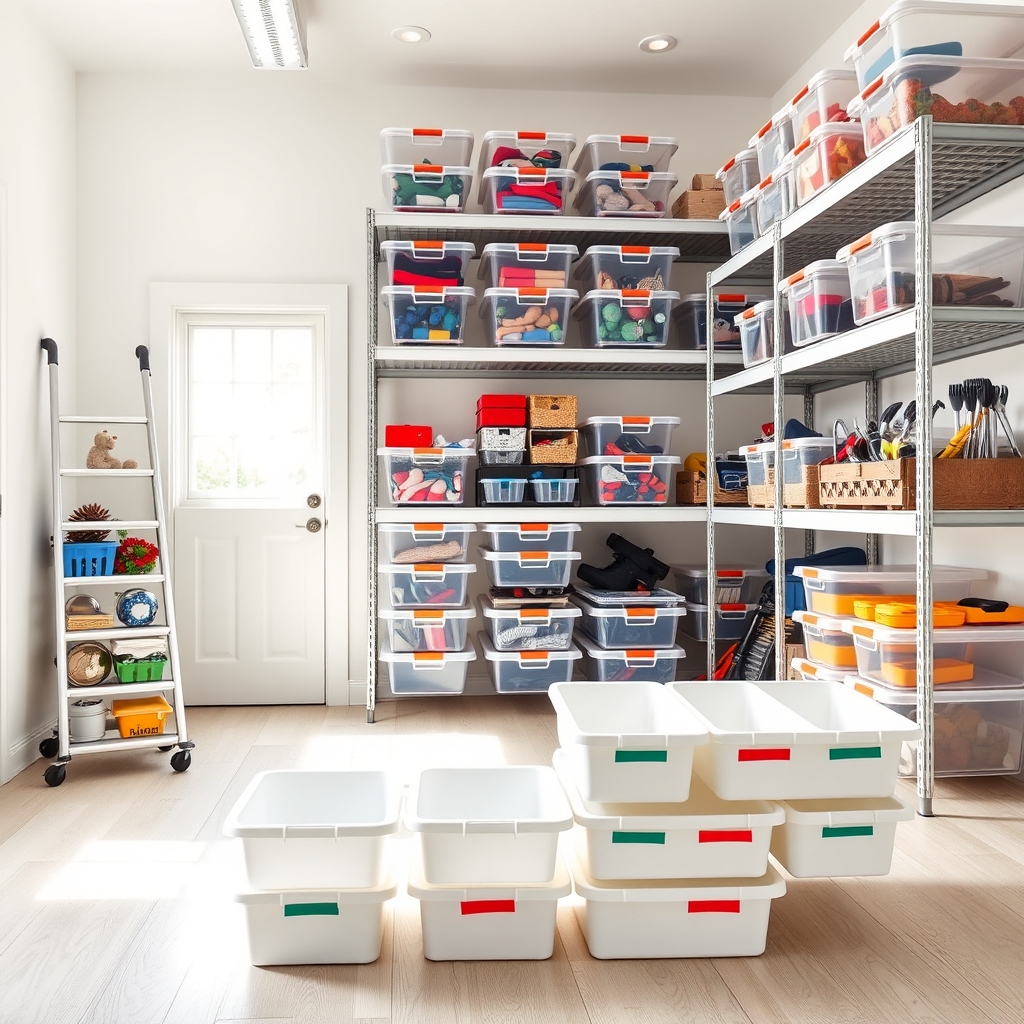
A well-organized storage room serves as the backbone of an efficient household, allowing quick access to belongings while maximizing available space. The process of clearing out and categorizing items is the crucial first step in creating a functional storage system that will save time and reduce stress in the long run.
Before diving into organization, understanding that proper categorization creates a foundation for long-term storage success is essential. This initial investment of time and effort will establish clear zones for different types of items, making future retrieval and maintenance significantly easier.
Required Items:
- Large boxes or bins
- Garbage bags
- Labels and marker
- Sorting containers
- Storage shelves
- Protective gloves
- Cleaning supplies
- Notepad and pen
- Camera (for inventory)
- Clear plastic bags
Start by removing everything from the storage room and creating four distinct sorting areas: keep, donate, sell, and dispose. As items are removed, clean them and assess their condition. Group similar items together, such as holiday decorations, sporting equipment, tools, or seasonal clothing.
Create broad categories first, then break them down into subcategories based on use frequency and logical groupings.
Once items are sorted, document your inventory with photos and lists, noting which items are used frequently and which are accessed only occasionally. This information will help determine optimal placement when returning items to the storage room.
Before returning anything, thoroughly clean the empty storage space and install any necessary shelving or organizational systems.
For maximum organization success, implement a labeling system that clearly identifies the contents of each container or zone. Consider using clear containers for frequently accessed items and maintain a master inventory list.
Schedule regular maintenance checks every six months to ensure the organization system remains functional and to prevent accumulation of unnecessary items.
Plan Your Storage Layout
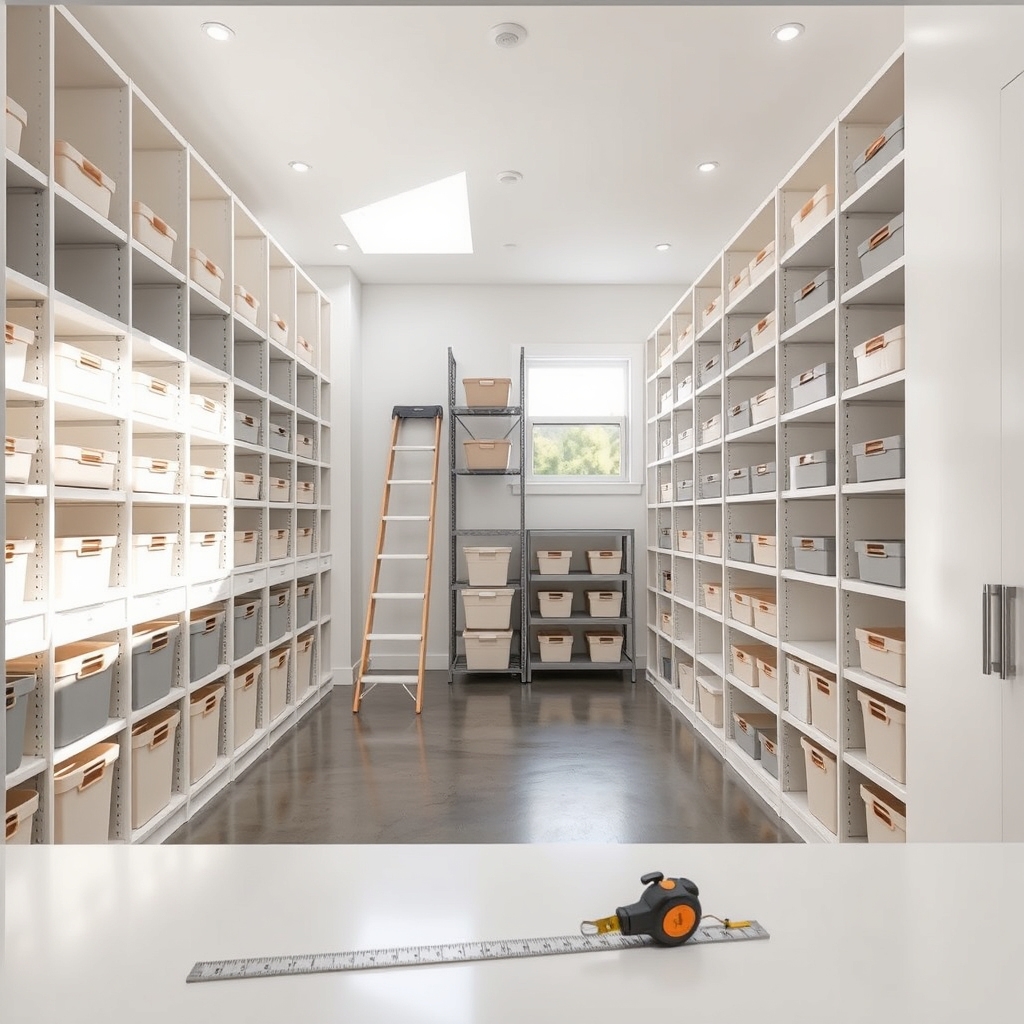
A well-planned storage room layout is the foundation of an organized and efficient home storage system. Without proper planning, even the most spacious storage areas can quickly become cluttered and difficult to navigate, leading to wasted space and forgotten items buried beneath layers of disorganization.
Taking the time to create a strategic layout maximizes every square foot while ensuring frequently accessed items remain easily reachable. A thoughtfully designed storage room becomes an invaluable asset that simplifies home organization and creates a stress-free environment for retrieving and storing household items.
Required Items:
- Measuring tape
- Graph paper
- Pencil and eraser
- Calculator
- Notepad
- Storage room dimensions
- Inventory list of items to store
- Camera or smartphone
- Masking tape
- Level
Begin by measuring your storage room’s exact dimensions, including the height, width, and depth. Map these measurements onto graph paper, noting the location of doors, windows, electrical outlets, and any permanent fixtures.
Divide your storage items into categories based on frequency of use, size, and weight. Heavy items should be placed along walls with proper support, while frequently accessed items belong near the entrance. Create clear pathways at least 36 inches wide to ensure easy movement throughout the space.
Consider vertical storage opportunities by planning shelving units that extend from floor to ceiling. Designate specific zones for different categories: seasonal items can be stored in harder-to-reach areas, while everyday items should remain at eye level. Account for future growth by leaving approximately 20% of your storage space unallocated.
Additional Tips: Incorporate adjustable storage solutions like modular shelving systems to allow for flexibility as your storage needs change. Label your planned zones clearly on your layout diagram and consider using color coding to make the organizational system more intuitive.
Remember to plan lighting requirements for each zone and ensure adequate ventilation to protect stored items from moisture damage.
Choose the Right Storage Solutions
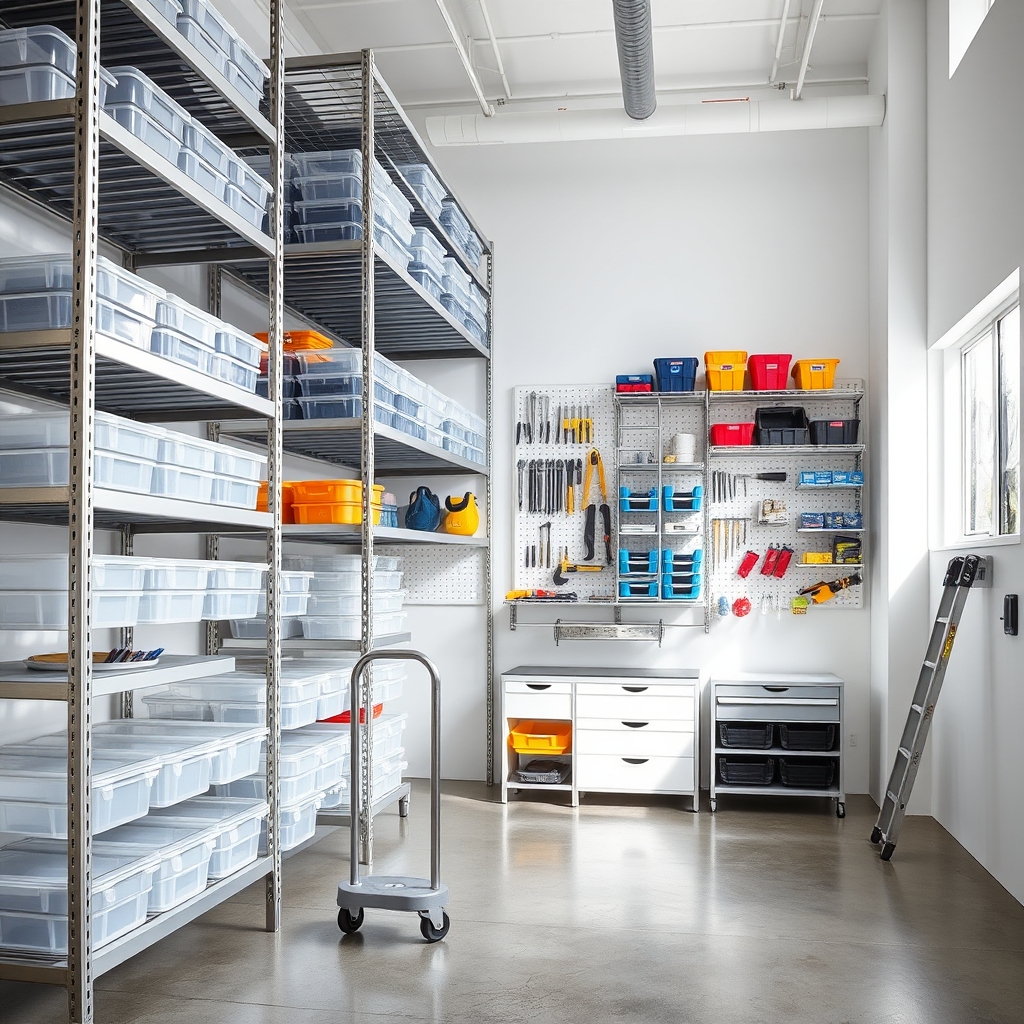
Selecting appropriate storage solutions is the foundation of creating an efficient and functional storage room. Without the right combination of shelving, containers, and organizational systems, even the most spacious storage area can quickly become cluttered and difficult to navigate, ultimately defeating its purpose.
The key to maximizing storage space lies in choosing solutions that complement both the items being stored and the room’s dimensions. Proper storage solutions not only protect your belongings but also make them easily accessible while optimizing every square foot of available space, from floor to ceiling.
Required Items:
- Adjustable metal shelving units
- Clear plastic storage bins
- Label maker
- Measuring tape
- Heavy-duty hooks
- Pegboard panels
- Drawer organizers
- Stackable containers
- Airtight storage containers
- Utility cart
- Step ladder
- Shelf liners
Start by measuring your storage room’s dimensions, including ceiling height, doorway width, and any architectural features that might affect storage placement. Group similar items together and assess their size, weight, and frequency of use. Select shelving units that can handle the weight of your items and adjust to different heights as needed.
For frequently accessed items, choose solutions that allow easy visibility and access, such as clear bins or open shelving. Install pegboards on walls for tools and smaller items, and utilize vertical space with tall, sturdy shelving units.
Consider investing in specialized storage solutions for specific items: moisture-resistant containers for seasonal decorations, reinforced shelving for heavy tools, and climate-controlled solutions for sensitive materials. Implement a combination of fixed and mobile storage options, such as rolling carts for frequently moved items and permanent shelving for long-term storage.
To maximize the effectiveness of your storage solutions, incorporate a regular maintenance schedule to evaluate and adjust your system as needed. Use clear labeling on all containers and create a storage map or inventory list to track item locations.
Remember to leave adequate aisle space between storage units for easy access and consider future storage needs when planning your layout, allowing room for expansion or modification as your storage requirements change.
Install Proper Lighting and Ventilation
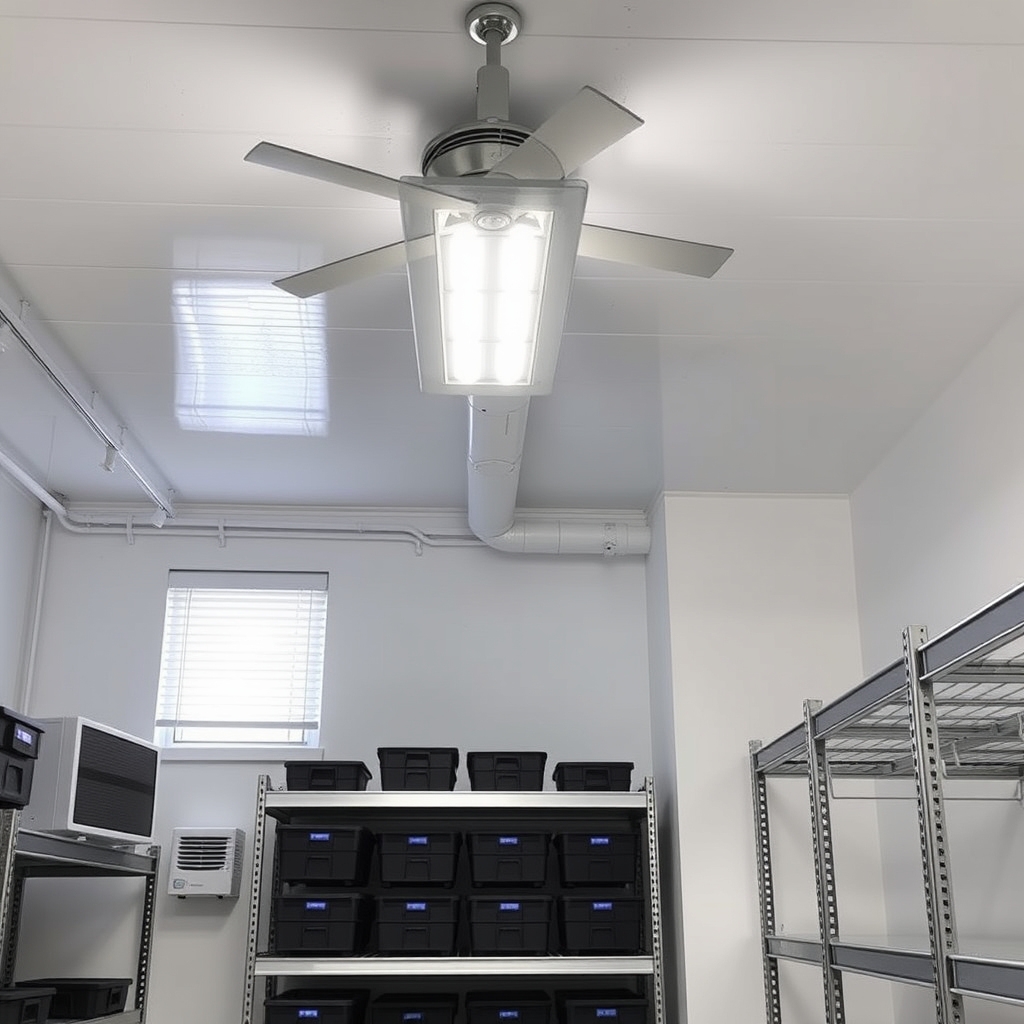
Proper lighting and ventilation in a storage room are crucial elements that often get overlooked during the planning phase. Adequate lighting ensures you can easily locate items, inspect for damage or pests, and safely navigate the space. Meanwhile, proper ventilation helps prevent moisture buildup, mold growth, and maintains appropriate temperature levels for stored items.
When storage spaces lack proper illumination and air circulation, items can deteriorate faster, and the room becomes less functional and potentially hazardous. Installing an efficient lighting and ventilation system not only protects your belongings but also transforms a dark, stuffy storage room into a practical, accessible space that’s pleasant to use.
Required Items:
- LED light fixtures
- Light switches
- Electrical wiring
- Ceiling or wall vents
- Exhaust fan
- Dehumidifier
- Humidity meter
- Basic tools (screwdrivers, wire strippers, drill)
- Step ladder
- Extension cord
- Circuit tester
Install overhead LED lights in a grid pattern, ensuring coverage of all storage areas. Begin by mapping electrical connections and installing junction boxes at strategic points. Mount light fixtures approximately 8 feet apart for even illumination.
For ventilation, install an exhaust fan near the ceiling and passive vents at lower levels to create proper air circulation. If possible, add a window or door vent to promote natural airflow. Consider installing motion sensors for automated lighting in frequently accessed areas.
Set up a dehumidifier in a central location and connect it to a drain or position it where you can easily empty it. Monitor humidity levels regularly to maintain optimal conditions between 30-50%. Ensure all electrical installations comply with local building codes and consider consulting a professional electrician for complex wiring tasks.
Additional Tips: Supplement overhead lighting with battery-operated motion-sensor lights in deep corners or shelving units. Create a maintenance schedule to regularly test lighting systems, clean vents, and check humidity levels. Consider installing a backup battery-operated light system for emergencies, and label all switches and controls clearly for easy operation.
Implement an Organization System
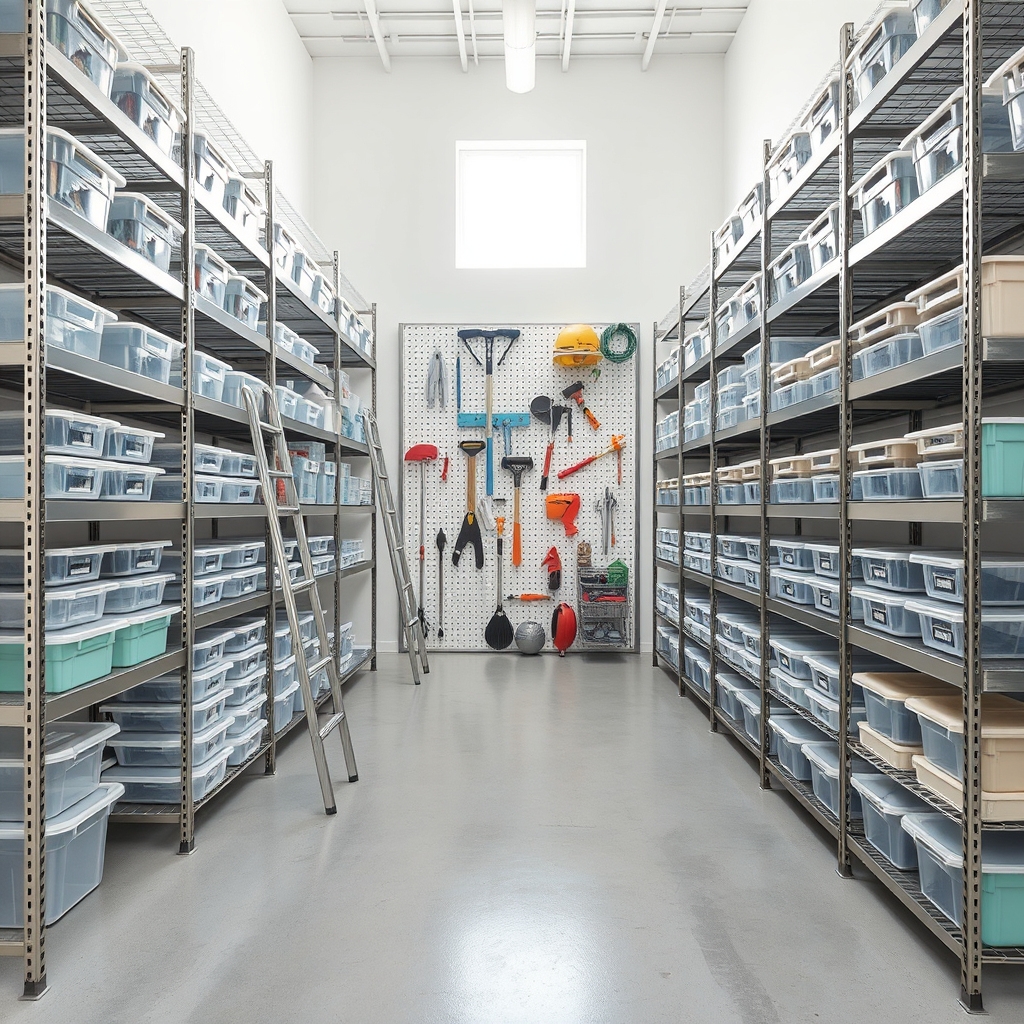
A well-organized storage room serves as the backbone of an efficient household, allowing quick access to seasonal items, supplies, and cherished possessions while maximizing available space.
Without a proper organization system, storage rooms can quickly become chaotic catch-all spaces that waste valuable time and create frustration when searching for specific items.
Implementing a systematic approach to storage room organization transforms this often-neglected space into a functional asset for your home. An effective organization system not only creates designated spaces for different categories of items but also establishes sustainable habits that maintain order long-term.
Required Items:
- Label maker or labels
- Clear storage containers
- Shelving units
- Storage bins
- Measuring tape
- Marker pen
- Pegboard or wall organizers
- Storage rack
- Dust-proof covers
- Drawer organizers
Start by emptying the entire storage room and sorting items into categories such as seasonal decorations, sporting equipment, tools, and archived documents.
Measure the space and install adjustable shelving units along the walls, ensuring proper weight distribution and accessibility. Create zones within the room based on usage frequency, with frequently accessed items at eye level and seasonal items stored higher or in less accessible areas.
Utilize clear containers for visibility and stack similar-sized boxes together for optimal space usage. Implement a labeling system that includes both the contents and the date of storage.
Create an inventory list or map of the storage room’s layout, noting where specific categories are located. Install pegboards or wall-mounted organizers for tools and frequently used items that benefit from vertical storage.
Additional Tips: Maintain clear pathways between storage zones and review contents annually to prevent accumulation of unnecessary items.
Consider using vacuum storage bags for soft goods and implementing a rotation system for seasonal items. Take photos of organized sections to serve as reference points when returning items to their designated spots, and keep a small stepladder in the room for safely accessing items stored at height.
Establish Zones for Different Items
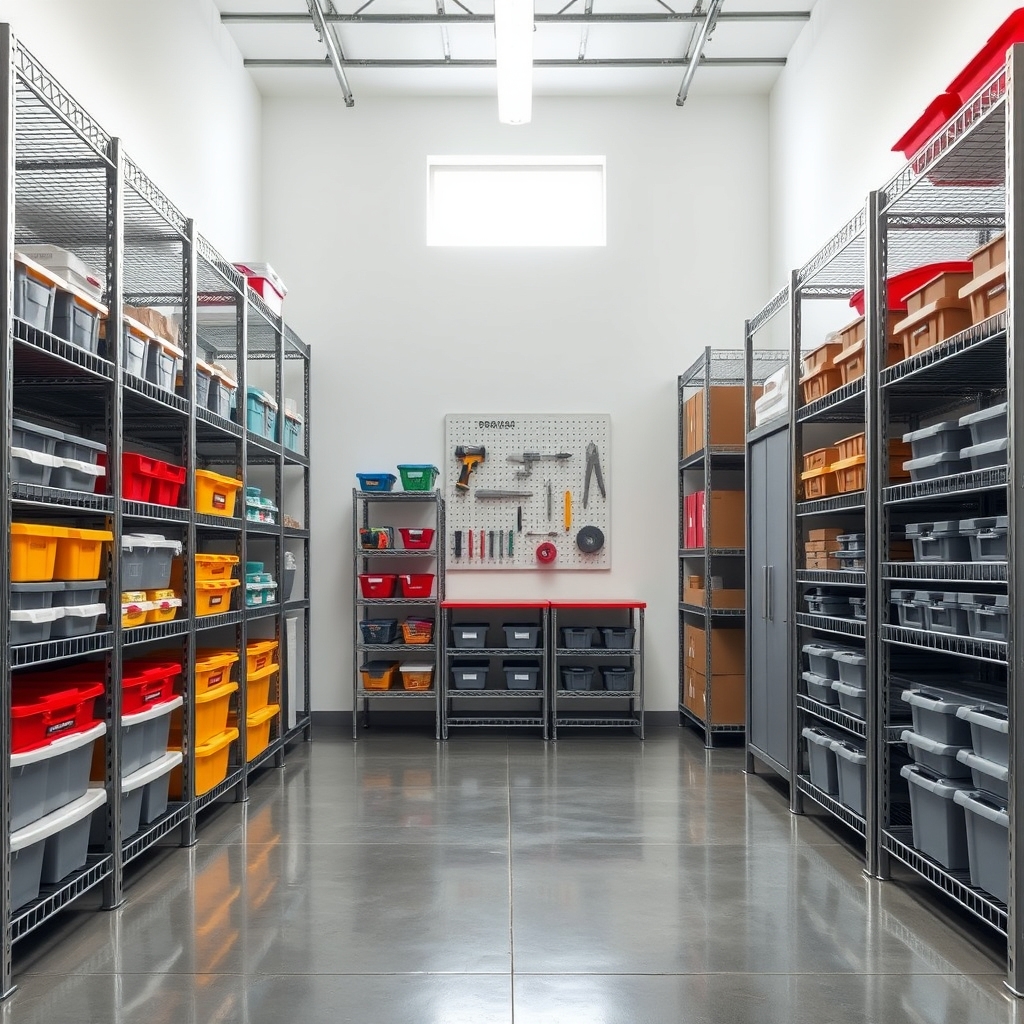
Creating distinct zones in your storage room is fundamental to maintaining an organized and efficient space. Without proper zones, items become mixed together, making it difficult to locate what you need and increasing the likelihood of clutter accumulation over time.
Establishing well-defined zones transforms a chaotic storage space into a systematic, easy-to-navigate area where every item has its designated place. This zoning system not only makes it easier to find and retrieve items but also simplifies the process of returning things to their proper locations, ensuring long-term organization success.
Required Items:
- Labels or label maker
- Storage bins and containers
- Shelving units
- Measuring tape
- Clipboard and paper
- Markers
- Masking tape
- Storage racks
- Clear plastic containers
- Pegboard or wall organizers
Start by measuring your storage room and sketching a basic floor plan. Divide the space into broad categories based on item type and frequency of use: seasonal items, household supplies, tools and maintenance equipment, sporting goods, and archived documents.
Position frequently accessed items near the entrance and less-used items toward the back. Create clear pathways between zones, ensuring each area is easily accessible. Install appropriate shelving and storage solutions specific to each zone’s needs.
When establishing boundaries between zones, use visual markers such as different colored labels, floor tape, or varying storage container types. Install vertical storage solutions that maximize space efficiency while keeping items visible and accessible.
Consider the weight and size of items when determining zone placement, keeping heavier items at waist level and lighter items on higher or lower shelves.
For optimal zone maintenance, implement a “return to zone” policy where items must be placed back in their designated areas immediately after use. Create an inventory list for each zone and update it regularly.
Consider seasonal rotation of items between zones based on usage patterns, and leave some empty space in each zone for future additions or temporary storage needs.
Label and Create an Inventory System
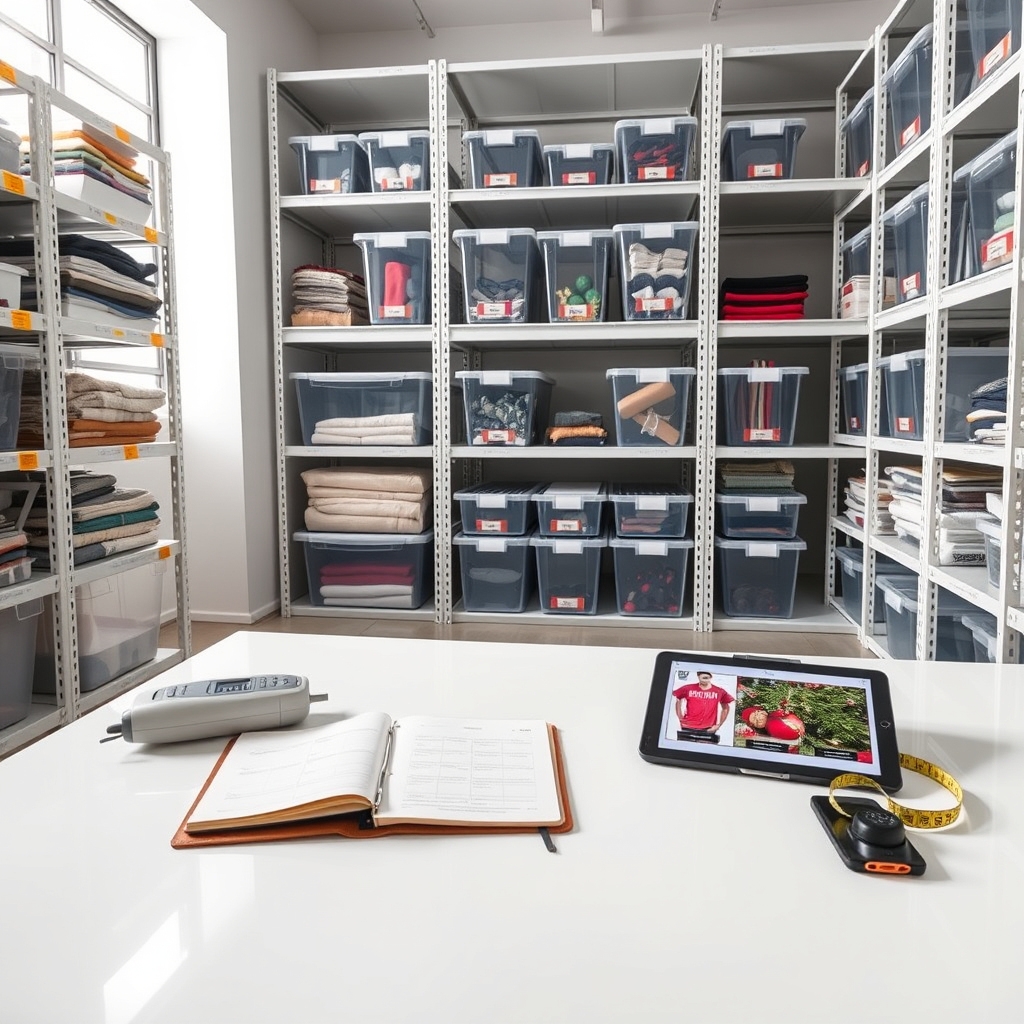
A well-organized inventory system transforms a chaotic storage room into an efficient, accessible space where every item has its place and can be located within seconds. Without proper labeling and tracking, even the most organized storage rooms can quickly become difficult to navigate, leading to wasted time searching for items and unnecessary duplicate purchases.
Creating an effective inventory system involves more than just applying labels – it requires a methodical approach to categorizing, documenting, and maintaining a record of your stored items. This system becomes particularly valuable during seasonal changes, home projects, or when trying to locate specific items among numerous storage containers.
Required Items:
- Label maker or permanent markers
- Adhesive labels or label sheets
- Inventory notebook or digital spreadsheet
- Clear plastic bins
- Storage containers
- Box numbers or codes
- Camera or smartphone
- Measuring tape
- Storage location map
- Filing system for inventory records
Start by dividing your storage room into distinct zones based on categories (holiday decorations, tools, camping gear, etc.). Assign each zone a letter code and number each container within that zone.
Create a detailed spreadsheet or inventory book that lists every item’s location using the zone and container numbers. Photograph the contents of each container before sealing and attach a comprehensive label listing major contents. Ensure labels are visible from multiple angles and include the zone code, container number, and a brief content description.
Add multiple details to your inventory system, including the container’s dimensions, weight restrictions, and any specific storage requirements (temperature sensitivity, fragility). Create a simple floor plan of your storage room, marking zones clearly and noting the location of each container. This visual reference helps maintain organization when items are removed or new ones are added.
For optimal results, schedule quarterly inventory reviews to update your system, remove outdated items, and reorganize as needed. Consider using a digital inventory app that allows barcode scanning and photo attachments for easier tracking.
Keep a “recently accessed” log to identify frequently used items that might need more accessible placement, and maintain a separate list of items that require regular maintenance or replacement.


